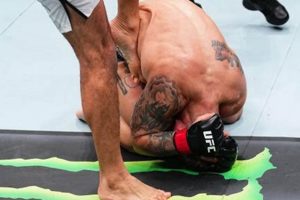A multiple-opponent combat scenario within mixed martial arts presents a unique set of challenges and tactical considerations. Imagine a situation where a single combatant faces two opponents simultaneously. This drastically alters the dynamics of a typical one-on-one fight, demanding heightened awareness, strategic positioning, and efficient resource management from the outnumbered fighter. Conversely, the paired combatants must coordinate their attacks and avoid hindering each other to capitalize on their numerical advantage.
Such scenarios, while rare in professional regulated competition, offer valuable insights into combat principles applicable to self-defense situations. Analyzing these asymmetric engagements can illuminate effective strategies for managing multiple attackers, emphasizing the importance of situational awareness, footwork, and target prioritization. Historically, depictions of multiple-opponent combat are common in martial arts cinema, often showcasing specialized techniques and strategies designed to overcome numerical disadvantages. This reflects a longstanding interest in the complexities and challenges inherent in such confrontations.
The following sections will delve deeper into specific aspects of outnumbered combat within the context of mixed martial arts. Topics covered will include effective defensive maneuvers, offensive strategies, the role of teamwork in multiple-attacker situations, and the ethical considerations associated with such uneven matchups.
Tips for Managing Multiple Opponents in MMA
Combating multiple adversaries presents significant challenges. The following tactical considerations can improve survivability and potentially create opportunities for victory in such a precarious scenario.
Tip 1: Maintain Situational Awareness: Constant vigilance is paramount. Continuously scan the environment, tracking both opponents’ positions and movements. Anticipating attacks is crucial for effective defense.
Tip 2: Control the Engagement Area: Position oneself to avoid being flanked or surrounded. Utilizing obstacles or the environment to create a bottleneck can limit the opponents’ ability to attack simultaneously.
Tip 3: Prioritize Targets: Focus attacks on one opponent at a time. Neutralizing a single threat quickly reduces the numerical disadvantage and can demoralize the remaining combatant.
Tip 4: Efficient Movement: Footwork is essential. Maintain mobility to evade attacks and create angles for counter-offense. Avoid getting trapped against a cage or corner.
Tip 5: Conserve Energy: Facing multiple opponents requires judicious energy expenditure. Avoid unnecessary movements or prolonged grappling exchanges that can lead to exhaustion.
Tip 6: Exploit Openings: Capitalize on any mistakes or miscommunication between opponents. A coordinated attack by two individuals can create vulnerabilities if not executed precisely.
Tip 7: Create Distance When Necessary: If overwhelmed, creating distance can provide valuable time to reassess the situation and regain composure before re-engaging.
By implementing these strategies, a practitioner can significantly improve their chances of surviving and potentially prevailing in a multiple-opponent scenario. These tips emphasize the importance of strategic thinking, efficient movement, and decisive action under pressure.
This analysis of multiple-opponent combat provides valuable insights into the complexities of such encounters, highlighting the importance of preparation and adaptable strategies.
1. Numerical Disadvantage
Numerical disadvantage forms the core challenge of a two-on-one MMA fight. This inherent imbalance forces the single combatant into a reactive position, prioritizing defense and seeking opportunities to exploit any weaknesses in the opponents’ coordination. The outnumbered fighter faces a constant threat from multiple angles, requiring heightened awareness and rapid decision-making. This inherent asymmetry distinguishes such scenarios from traditional one-on-one combat, demanding a distinct set of strategies and tactical considerations. For instance, a fighter facing two opponents cannot afford to engage in prolonged grappling with one, risking vulnerability to strikes from the other. This exemplifies how numerical disparity necessitates a different approach to combat.
The impact of numerical disadvantage extends beyond simple offensive pressure. It affects energy expenditure, strategic options, and psychological burden. The lone fighter must manage energy reserves carefully, knowing fatigue can be exploited quickly. Movement becomes restricted, as maneuvering to engage one opponent might expose vulnerabilities to the other. Maintaining composure under such duress presents a significant psychological challenge. Consider a scenario where one opponent feints an attack while the other launches a simultaneous strike from a blind spot; the lone fighter’s ability to process information and react decisively under pressure becomes paramount.
Understanding the profound impact of numerical disadvantage is critical for analyzing two-on-one combat scenarios. It highlights the necessity of strategic adaptation, efficient resource management, and the importance of exploiting any weaknesses in the opponents’ coordinated efforts. This understanding offers valuable insights applicable to self-defense training and provides a framework for evaluating the tactical complexities of unevenly matched confrontations.
2. Strategic Positioning
Strategic positioning plays a vital role in two-on-one MMA scenarios. The outnumbered fighter must constantly manipulate their position to avoid being flanked or surrounded. Maintaining an advantageous angle, ideally with one opponent partially obscuring the other, limits the effectiveness of simultaneous attacks. This maneuvering creates opportunities to engage each opponent individually, mitigating the numerical disadvantage. Positioning also dictates control of the fighting area. Using cage walls or ring ropes to restrict movement can further limit the opponents’ ability to coordinate attacks. Consider a fighter backing away from two advancing opponents; by maneuvering towards a corner, they can force a bottleneck, preventing both attackers from engaging simultaneously.
Effective positioning also considers potential escape routes and environmental factors. Proximity to the cage or ring ropes can limit mobility and present additional challenges. Awareness of these boundaries influences strategic movement and informs defensive maneuvers. For example, a fighter positioned near the cage wall can use it to pivot and create distance, potentially disrupting the opponents’ coordinated attack. Understanding how the environment can be utilized, both offensively and defensively, enhances the effectiveness of strategic positioning. Imagine a scenario where a fighter uses a ring post to obstruct one opponent’s line of sight while simultaneously delivering a kick to the other; this illustrates how combining environment awareness with precise positioning can create advantageous opportunities.
In summary, strategic positioning serves as a cornerstone of effective defense in two-on-one MMA scenarios. It mitigates numerical disadvantage by controlling the engagement area, limiting simultaneous attacks, and creating opportunities for individual engagement. Combining this with environmental awareness further enhances the outnumbered fighter’s ability to survive and potentially prevail. This understanding has practical significance not only for competitive fighters but also for self-defense applications, highlighting the importance of spatial awareness and strategic movement in any multi-opponent confrontation.
3. Teamwork Coordination
Teamwork coordination is paramount in two-on-one MMA scenarios, dictating the effectiveness of the paired fighters. Success hinges on synchronized attacks, efficient communication, and an understanding of each other’s strengths and weaknesses. This coordinated effort aims to overwhelm the single opponent, exploiting the numerical advantage through strategic positioning and combined offensive maneuvers. Without effective teamwork, the two fighters risk hindering each other, potentially neutralizing their numerical advantage and creating vulnerabilities.
- Synchronized Attacks:
Synchronized attacks involve timed strikes and grappling maneuvers designed to overwhelm the single opponent. For example, one fighter might secure a clinch while the other delivers strikes. Effective synchronization requires precise timing and clear communication, minimizing the opportunity for the opponent to capitalize on openings. Failed synchronization can lead to friendly fire or create opportunities for the outnumbered fighter to counterattack.
- Fluid Positioning and Switching:
Maintaining optimal positioning while avoiding interference with one’s partner is crucial. Fluid switching of roles, from attacker to defender, allows the team to maintain continuous pressure while minimizing individual fatigue. This dynamic positioning necessitates constant communication and awareness of the opponent’s movements. For instance, one fighter might apply pressure with strikes while the other circles to cut off escape routes, seamlessly switching roles as the situation evolves.
- Exploiting Openings Created by the Partner:
Effective teamwork involves capitalizing on opportunities created by the partner’s actions. One fighter might use a feint or a specific attack to draw the opponent’s attention, creating an opening for the other to strike. This requires anticipation and an understanding of the partner’s fighting style. A failed attempt to exploit such an opening can leave one team member vulnerable to a counterattack.
- Communication and Adaptation:
Clear and concise communication, even non-verbal cues, are essential for successful teamwork. Adapting to the opponent’s reactions and adjusting the strategy mid-fight requires ongoing communication. For example, a quick signal can indicate a switch in tactics if the initial approach proves ineffective. A lack of communication can lead to confusion and diminish the effectiveness of the team’s combined efforts.
In the context of a two-on-one MMA fight, these facets of teamwork coordination become critical determinants of success. While individual skill remains important, the ability to function as a cohesive unit amplifies the numerical advantage, creating a synergistic effect that can overwhelm even a highly skilled single opponent. Understanding these principles provides valuable insights into the complexities of multi-opponent combat, highlighting the strategic depth beyond individual fighting prowess.
4. Individual Skill Gap
Individual skill disparity significantly influences the outcome of a two-on-one MMA scenario. A substantial skill gap can negate the numerical advantage of the paired fighters. A highly skilled individual might effectively neutralize two less experienced opponents through superior technique, strategy, and execution. Conversely, a significant skill deficit can exacerbate the inherent disadvantage of facing multiple opponents. Consider a scenario where a highly skilled grappler faces two strikers with limited grappling experience; the grappler might quickly neutralize one opponent with a submission hold, effectively turning the two-on-one into a more manageable one-on-one. This illustrates how a significant skill differential can override numerical advantage.
Analyzing historical examples from combat sports and martial arts further emphasizes the impact of individual skill. Instances exist where single combatants have successfully defended against multiple attackers due to superior training and adaptability. These cases often highlight the importance of efficient movement, target prioritization, and exploiting openings in the opponents’ coordinated attacks. Conversely, numerous examples demonstrate how a lack of individual skill can lead to rapid defeat, even with numerical superiority. This reinforces the understanding that skill disparity plays a crucial role, impacting both offensive and defensive capabilities within a two-on-one context.
Understanding the influence of individual skill gaps provides crucial context for analyzing two-on-one MMA scenarios. While numerical advantage presents a significant challenge, individual skill remains a critical factor. This understanding underscores the importance of continuous skill development and adaptable strategies in any combat situation, especially when facing multiple opponents. This knowledge has practical applications in self-defense training, emphasizing the importance of honing individual skills to mitigate potential threats, regardless of numerical disparity.
5. Ethical Implications
Staging a two-on-one MMA fight raises significant ethical concerns, particularly outside of carefully controlled training environments. The inherent imbalance of such a matchup presents a heightened risk of serious injury to the outnumbered combatant. This power dynamic necessitates careful consideration of the context, purpose, and potential consequences of such an encounter. Sanctioned professional MMA competitions strictly prohibit two-on-one scenarios precisely due to these ethical considerations. Even in training environments, stringent safety measures and controlled parameters are essential to mitigate risks.
The ethical implications extend beyond physical safety. The potential for psychological distress and humiliation for the outnumbered fighter cannot be ignored. Exploiting such a numerical advantage can be perceived as unfair and disrespectful, undermining the principles of sportsmanship and fair play. This holds true even in simulated combat or training scenarios. Consider a scenario where a novice fighter is placed against two more experienced training partners; the potential for discouragement and loss of confidence outweighs any perceived training benefit. Therefore, careful consideration of participant experience levels and psychological impact is essential when designing any training involving uneven numbers.
Understanding the ethical implications associated with two-on-one MMA fights is crucial for responsible practice and analysis. While such scenarios can offer insights into combat dynamics and defensive strategies, the inherent power imbalance necessitates a cautious approach. Prioritizing safety, respect, and fairness should guide any exploration of this type of combat, ensuring that the pursuit of knowledge or training does not compromise the well-being of participants. This ethical awareness promotes a responsible approach to combat training and fosters a culture of respect within the martial arts community.
Frequently Asked Questions about Two-on-One MMA Scenarios
This section addresses common questions and misconceptions surrounding the complexities and ethical considerations of two-versus-one combat in mixed martial arts.
Question 1: Are two-on-one fights allowed in professional MMA?
No. Professional MMA organizations strictly prohibit two-on-one fights due to safety concerns and ethical considerations regarding fair competition.
Question 2: Do two-on-one scenarios have any practical application in self-defense?
While rare, understanding the dynamics of multiple-attacker scenarios can inform self-defense strategies. Training in such situations can develop awareness, improve decision-making under pressure, and enhance defensive tactics.
Question 3: How can a single fighter effectively defend against two opponents?
Effective defense relies on strategic positioning, maintaining situational awareness, and prioritizing targets. Creating distance, exploiting openings in the opponents’ coordination, and efficient energy management are also crucial.
Question 4: What are the ethical considerations of training for two-on-one scenarios?
Safety is paramount. Stringent controls and protective measures are essential to minimize the risk of injury. Psychological factors, such as potential humiliation or discouragement, must also be considered, especially for less experienced practitioners.
Question 5: Can a significant skill difference overcome a numerical disadvantage?
Yes. A highly skilled individual can potentially neutralize multiple opponents with lesser skill through superior technique, strategy, and efficient execution.
Question 6: Are there examples of successful defenses against multiple attackers in real-world situations?
Documented instances exist, often highlighting the importance of training, situational awareness, and decisive action. However, these situations are inherently unpredictable and dangerous, underscoring the importance of avoiding such confrontations whenever possible.
Understanding the dynamics and ethical considerations of two-on-one combat scenarios is essential for responsible training and analysis. Prioritizing safety and respect for all participants remains paramount.
This concludes the FAQ section. The following section will offer further analysis of specific techniques and strategies applicable to multiple-opponent combat scenarios within the context of MMA.
Two-on-One MMA Combat
Analysis of two-on-one MMA scenarios reveals the complex interplay of numerical disparity, strategic positioning, teamwork coordination, individual skill discrepancies, and ethical considerations. While rare in professional competition due to inherent safety concerns and fairness principles, exploring these uneven matchups provides valuable insights into combat dynamics. Understanding the tactical challenges faced by both the outnumbered combatant and the paired attackers offers practical knowledge applicable to self-defense training and enhances understanding of broader combat principles. Key takeaways include the importance of situational awareness, efficient movement, target prioritization, and the critical role of teamwork in multiple-attacker situations. Furthermore, examination of ethical implications underscores the need for responsible training practices and careful consideration of potential risks.
Further research into multiple-attacker scenarios within various combat disciplines could yield valuable insights into effective defensive strategies and enhance preparedness for such situations. Continued emphasis on ethical considerations remains crucial for promoting responsible training practices and ensuring the safety of all participants. Ultimately, a comprehensive understanding of two-on-one combat dynamics contributes to a more nuanced appreciation of the complexities inherent in martial arts and self-defense.







